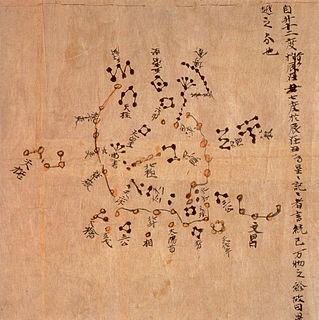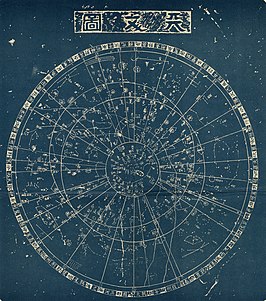
A constellation is a group of stars that forms an imaginary outline or pattern on the celestial sphere, typically representing an animal, mythological person or creature, a god, or an inanimate object.
Chinese star names are named according to ancient Chinese astronomy and astrology. The sky is divided into star mansions and asterisms. The system of 283 asterisms under Three Enclosures and Twenty-eight Mansions was established by Chen Zhuo of the Three Kingdoms period, who synthesized ancient constellations and the asterisms created by early astronomers Shi Shen, Gan De and Wu Xian. Since the Han and Jin Dynasties, stars have been given reference numbers within their asterisms in a system similar to the Bayer or Flamsteed designations, so that individual stars can be identified. For example, Deneb is referred to as 天津四.
The modern constellation Andromeda lies across two of the quadrants, symbolized by the Black Tortoise of the North and the White Tiger of the West, that divide the sky in traditional Chinese uranography.
According to traditional Chinese uranography, the modern constellation Aries is located within the western quadrant of the sky, which is symbolized as the White Tiger of the West.
According to traditional Chinese uranography, the modern constellation Cancer is located within the southern quadrant of the sky, which is symbolized as the Vermilion Bird of the South.
According to traditional Chinese uranography, the modern constellation Canis Major is located within the southern quadrant of the sky, which is symbolized as the Vermilion Bird of the South.
The modern constellation Carina lies across one of the quadrants symbolized by the Vermillion Bird of the South and The Southern Asterisms, that divide the sky in traditional Chinese uranography.
The modern constellation Crux is not included in the Three Enclosures and Twenty-Eight Mansions system of traditional Chinese uranography because its stars are too far south for observers in China to know about them prior to the introduction of Western star charts. Based on the work of Xu Guangqi and the German Jesuit missionary Johann Adam Schall von Bell in the late Ming Dynasty, this constellation has been classified as one of the 23 Southern Asterisms under the name Cross.
According to traditional Chinese uranography, the modern constellation Delphinus is located within the northern quadrant of the sky, which is symbolized as the Black Tortoise of the North.
The modern constellation Eridanus lies across one of the quadrants symbolized by the White Tiger of the West, and The Southern Asterisms, that divide the sky in traditional Chinese uranography.
The modern constellation Hydrus is not included in the Three Enclosures and Twenty-Eight Mansions system of traditional Chinese uranography because its stars are too far south for observers in China to know about them prior to the introduction of Western star charts. Based on the work of Xu Guangqi and the German Jesuit missionary Johann Adam Schall von Bell in the late Ming Dynasty, this constellation has been classified under the 23 Southern Asterisms with the names Snake's Tail, Snake's Abdomen, Snake's Head and White Patched Nearby.
The modern constellation Indus is not included in the Three Enclosures and Twenty-Eight Mansions system of traditional Chinese uranography because its stars are too far south for observers in China to know about them prior to the introduction of Western star charts. Based on the work of Xu Guangqi and the German Jesuit missionary Johann Adam Schall von Bell in the late Ming Dynasty, this constellation has been classified as one of the 23 Southern Asterisms under the name Persia.
According to traditional Chinese uranography, the modern constellation Libra is located within the eastern quadrant of the sky, which is symbolized as the Azure Dragon of the East.
The modern constellation Apus is not included in the Three Enclosures and Twenty-Eight Mansions system of traditional Chinese uranography because its stars are too far south for observers in China to know about them prior to the introduction of Western star charts. Based on the work of Xu Guangqi and the German Jesuit missionary Johann Adam Schall von Bell in the late Ming Dynasty, this constellation has been classified as one of the 23 Southern Asterisms under the name Exotic Bird.
The modern constellation Octans is not included in the Three Enclosures and Twenty-Eight Mansions system of traditional Chinese uranography because its stars are too far south for observers in China to know about them before the introduction of Western star charts. Based on the work of Xu Guangqi and the German Jesuit missionary Johann Adam Schall von Bell in the late Ming Dynasty, this constellation has been classified under the 23 Southern Asterisms with the names Snake's Tail and Exotic Bird.
The modern constellation Pavo is not included in the Three Enclosures and Twenty-Eight Mansions system of traditional Chinese uranography because its stars are too far south for observers in China to know about them prior to the introduction of Western star charts. Based on the work of Xu Guangqi and the German Jesuit missionary Johann Adam Schall von Bell in the late Ming Dynasty, this constellation has been classified as one of the 23 Southern Asterisms under the name Peacock.
The modern constellation Phoenix lies across one of the quadrants symbolized by the White Tiger of the West, and The Southern Asterisms, that divide the sky in traditional Chinese uranography.
The modern constellation Reticulum is not included in the Three Enclosures and Twenty-Eight Mansions system of traditional Chinese uranography because its stars are too far south for observers in China to know about them prior to the introduction of Western star charts. Based on the work of Xu Guangqi and the German Jesuit missionary Johann Adam Schall von Bell in the late Ming Dynasty, this constellation has been classified as two of the 23 Southern Asterisms under the name Snake's Head and White Patches Attached.
According to traditional Chinese uranography, the modern constellation Taurus is located within the western quadrant of the sky, which is symbolized as the White Tiger of the West (西方白虎).





